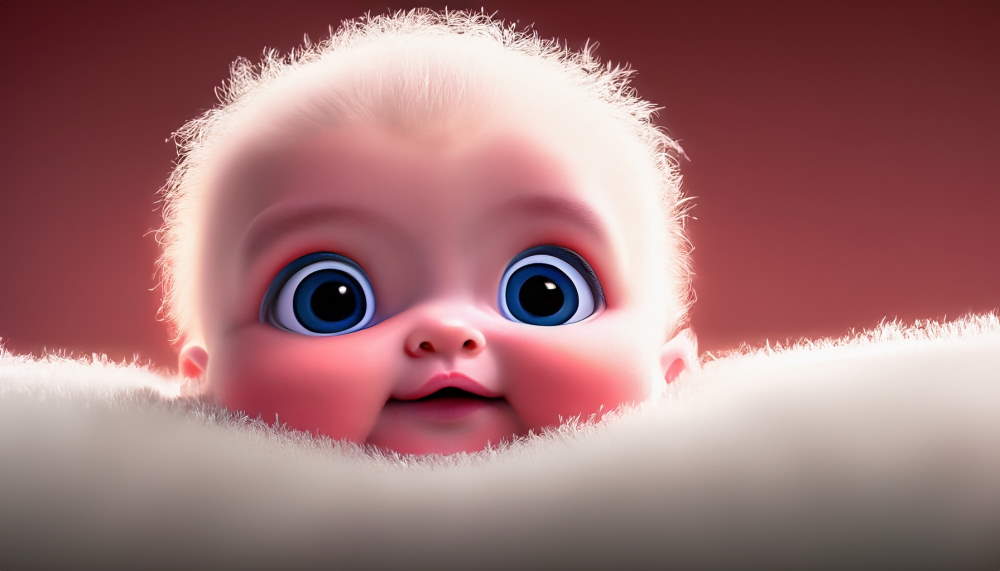Newborn babies have soft and silky hair, but as they grow older, their hair texture may change. In this blog post, we will explore when and why a baby’s hair texture changes, as well as the different hair textures that babies can have.
Around six to twelve months old, a baby’s hair starts to produce keratin, a protein that gives hair its strength and structure. As a baby’s hair produces more keratin, it will become thicker and curlier. However, not all babies will experience this type of texture change. Some may continue to have fine, soft hair into childhood.
Key Takeaways
- A baby’s hair texture usually changes around six to twelve months old due to the production of keratin.
- Not all babies will experience this texture change, and some may continue to have fine, soft hair into childhood.
- Different hair textures that babies can have include fine, coarse, and curly hair.
What Are The 3 Phases Of Hair Growth?
Hair growth occurs in three distinct phases: the anagen phase, the catagen phase, and the telogen phase. Each phase plays a crucial role in the growth and development of healthy hair.
The first phase, the anagen phase
The anagen phase is the first phase of hair growth, during which the hair follicle begins to grow. This phase can last anywhere from two to six years, and during this time, the hair will grow about half an inch per month. Most of the hair on your head is in the anagen phase, and the length of this phase is determined by genetics. After the anagen phase ends, your hair will enter the shorter catagen and telogen phases before starting again.
For babies, the anagen phase is also when their hair texture changes from fine and downy to thicker and coarser. This phase usually lasts until around six months, when the baby’s hair begins to enter the next growth stage.
The second phase, known as the catagen phase
The catagen phase is the second phase of hair growth, during which the hair follicle begins to shrink. This phase lasts for about two weeks, and during this time, the hair will stop growing. As babies grow, their hair will go through different phases. The second phase is known as the catagen phase, during which their hair may become finer and softer. However, every baby is different and will experience these changes at different times. If parents have any concerns about their baby’s hair, they should speak with their doctor.
The third and final phase is known as the telogen phase.
The telogen phase is the third and final phase of hair growth, during which the hair follicle rests. This phase can last for several months, and during this time, the hair will not grow. After the telogen phase is over, the follicle will enter the anagen phase and begin growing new hair.
In summary, the anagen phase is when the hair follicle begins to grow, the catagen phase is when the hair follicle begins to shrink, and the telogen phase is when the hair follicle rests. All babies go through these different phases of hair growth, and the texture of their hair will change depending on which phase they are in. By keeping an eye on their baby’s scalp, parents can monitor their little one’s hair growth and texture.
Want to know more about Redheads and ginger hair in babies? Click here
Fine Hair
Fine hair is a common hair texture for babies. It is thinner and softer than average hair, making it more prone to damage. When brushing or styling fine hair, extra care should be taken to prevent damage.
Coarse Hair
Coarse hair is thicker and has a rough and wiry feel. It is less common in babies, but it is nothing to worry about. Coarse hair can be susceptible to damage if not treated carefully, just like fine hair.
Curly Hair
Curly hair is the least common of the three hair textures found in babies. It is characterized by tight, spiral-shaped curls. Curly hair, like fine and coarse hair, can be delicate and require gentle care. It is important to brush or comb your baby’s hair gently to avoid damage. Additionally, it is recommended to use products specifically designed for baby hair to keep their scalp healthy and happy. Taking good care of your baby’s curly hair will help maintain its natural texture and prevent any damage or breakage.
What Makes The Baby’s Hair Straight Or Curly?
The texture of a baby’s hair is determined by the shape of the follicle, which is the tiny opening in the skin from which the hair shaft grows. Baby’s hair follicles are round, giving their hair a straight texture. As people get older, their follicles begin to change shape and become oval-shaped, which is what gives our hair its natural curl.
The change in follicle shape can happen at different times for different people. Some individuals may start to see a change in their hair texture in their early teens, while others may not see any changes until they are much older. There are even some people who never experience a change in their follicle shape, and they keep their straight hair for their whole lives.
It is important to note that genetics play a significant role in determining hair texture. The genes inherited from parents can influence the shape of the follicle and, therefore, the texture of the hair.
In summary, the shape of the follicle determines whether a baby’s hair is straight or curly. As people age, their follicles change shape, which can result in a change in hair texture. However, the timing of this change varies from person to person, and genetics also play a role in determining hair texture.
Will Shaving Your Baby’s Head Make the Hair Grow Thicker?
Many parents believe that shaving their baby’s head will make the hair grow back thicker. However, there is no scientific evidence to support this claim. Hair growth is determined by genetics, hormones, and other factors, not by shaving.
A baby’s hair texture changes when they are around six months old as their hair starts to become thicker and more coarse. This is because the hairs start to grow in with the adult-like hair follicles, which are larger and can grow thicker hairs. Therefore, if parents want their baby to have thick, luscious locks, they may want to wait until they are a little older.
In summary, shaving a baby’s head will not make their hair grow back thicker. While some parents may swear by this practice, there is no scientific evidence to support it.
Will Cutting Your Baby’s Hair Change the Texture?
Cutting your baby’s hair will not change the texture. However, it can affect the way their hair looks and feels. To change the texture of your baby’s hair, different hairstyles or products can be tried. For instance, if you want to add more curl to their hair, a perm or spiral perm can be tried. To add body or volume, a volumizing shampoo and conditioner can be used. Additionally, products that contain silicone can be used to tame frizziness.
How to Care for Your Baby’s Hair
As babies grow, their hair goes through different stages. At birth, most babies have fine, downy hair called lanugo, which usually falls out within the first few months. After this, the hair becomes thicker and coarser, which is normal and nothing to worry about.
To care for your baby’s hair, use a soft-bristled brush or comb when brushing it. Be gentle when shampooing their scalp and use a mild baby shampoo or one designed for sensitive skin. Avoid using products with harsh chemicals or fragrances.
It’s best to avoid using too much heat when styling their hair. If heat is necessary, use a low setting and protect their hair with a serum or oil.
By following these simple tips, you can help keep your baby’s hair healthy and looking its best. If you have any concerns about your baby’s hair, talk to their pediatrician for more advice.
Remember that every baby’s hair is different, and it’s important to find what works best for your baby’s hair type. With proper care, your baby’s hair will grow and thrive.
How often should I wash my baby’s hair?
It is not necessary to wash a baby’s hair every day. Washing it too often can remove the natural oils that keep their scalp healthy. A good rule of thumb is to shampoo their hair every other day or every three days if they do not have much hair.
If a baby has cradle cap, parents may need to shampoo more often to help remove the scales. It is important to use mild baby shampoo and avoid scrubbing their scalp too hard. Gently massaging the shampoo into their scalp with fingertips before rinsing it out is recommended.
Parents should shampoo their baby’s hair when they see oil or dirt on their scalp or when their hair starts to look greasy. If they are not sure how often to wash their baby’s hair, they can ask their pediatrician for advice.
Conclusion
Baby hair texture can change at any time from birth to three years old. It is a normal part of growing up, and parents should not be concerned if they notice a change in their child’s hair texture. Watching a child grow and change day by day is a joyful experience.
Frequently Asked Questions
When do babies’ hair change texture?
Babies’ hair texture can change at different stages of their development. Typically, babies are born with a soft, fine hair called lanugo, which is shed before birth. After birth, they may have vellus hair, also known as “peach fuzz,” covering their scalp. Vellus hair can change texture and thickness as the baby grows.
What are the stages of baby hair growth?
There are three stages of baby hair growth. The first stage is lanugo, which is the soft, fine hair that covers a baby’s body before birth. The second stage is vellus hair, which is the fine, wispy hair that grows on a baby’s scalp after birth. The third stage is terminal hair, which is the thicker, coarser hair that grows on the scalp and body during childhood and adolescence.
Can baby hair texture change over time?
Yes, baby hair texture can change over time. Vellus hair, which is the fine, wispy hair that grows on a baby’s scalp after birth, can change texture and thickness as the baby grows. Additionally, the texture and thickness of terminal hair, which is the thicker, coarser hair that grows on the scalp and body during childhood and adolescence, can also change over time.
How can I predict my baby’s hair texture?
It is difficult to predict a baby’s hair texture, as it can be influenced by a variety of factors such as genetics and ethnicity. However, observing the texture and thickness of the baby’s hair at birth can provide some indication of what their hair texture might be like as they grow.
What factors influence baby hair texture?
Several factors can influence baby hair texture, including genetics, ethnicity, hormonal changes, and nutritional status. Genetics play a significant role in determining hair texture, as certain genes are responsible for producing different types of hair. Ethnicity can also affect hair texture, as individuals of different ethnicities tend to have different hair types. Hormonal changes, such as those that occur during puberty, can also affect hair texture. Finally, nutritional deficiencies can lead to changes in hair texture and growth.
When do babies’ hair start to grow thicker?
Babies’ hair typically starts to grow thicker during the third stage of hair growth, which is terminal hair. This stage usually occurs during childhood and adolescence, and is characterized by the growth of thicker, coarser hair on the scalp and body. The exact timing of this stage can vary from child to child.


